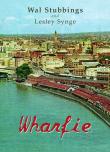AustLit
Latest Issues
AbstractHistoryArchive Description
'Wal Stubbings (1913-2014) was an Australian waterside worker for 40 years. Militant workers like him were demonised and accused of wrecking the country. So what was it like to be a wharfie? Especially one who visited the USSR, was involved in street marches, and was under ASIO surveillance yet survived with all his mental facilities intact to the ripe old age of 101? This is one man's journey through a tumultuous century.' (Publication summary)
Publication Details of Only Known VersionEarliest 2 Known Versions of
Works about this Work
-
[Review Essay] Wharfie
2018
single work
essay
— Appears in: Social Alternatives , vol. 37 no. 1 2018; (p. 63-64)'This memoir of a waterside worker through the 20th century is presented as an autobiography by Wal Stubbings but, if the text is the measure of authorship, much of the credit for the memoir must go to Lesley Synge, who is rightly credited as 'co-author'. It appears that the project to produce a memoir of Wal Stubbings' life and career emerged out of a general family history in 2000 to which he contributed a section. As Synge mentions in her foreword, this autobiographical piece became the 'master document' for the subsequent memoir. With this, she gathered information from further writings by Wal Stubbings, along with many stories written about him by family members, and other archival material including photographs, interviews and newspaper cuttings. Indeed, it was a complex task absorbing all this material and structuring it into a chronological narrative, in the first person voice of a man whose presence and perspectives on life were powerfully present in the source material. Synge has done an excellent job of editing and writing. She has presented us with a book that is accessible, well-organised and a pleasure to read.' (Introduction)
-
[Review] Wharfie
2017
single work
review
— Appears in: The Queensland Journal of Labour History , September no. 25 2017; (p. 59-62)
— Review of Wharfie 2017 single work autobiography
-
[Review] Wharfie
2017
single work
review
— Appears in: The Queensland Journal of Labour History , September no. 25 2017; (p. 59-62)
— Review of Wharfie 2017 single work autobiography -
[Review Essay] Wharfie
2018
single work
essay
— Appears in: Social Alternatives , vol. 37 no. 1 2018; (p. 63-64)'This memoir of a waterside worker through the 20th century is presented as an autobiography by Wal Stubbings but, if the text is the measure of authorship, much of the credit for the memoir must go to Lesley Synge, who is rightly credited as 'co-author'. It appears that the project to produce a memoir of Wal Stubbings' life and career emerged out of a general family history in 2000 to which he contributed a section. As Synge mentions in her foreword, this autobiographical piece became the 'master document' for the subsequent memoir. With this, she gathered information from further writings by Wal Stubbings, along with many stories written about him by family members, and other archival material including photographs, interviews and newspaper cuttings. Indeed, it was a complex task absorbing all this material and structuring it into a chronological narrative, in the first person voice of a man whose presence and perspectives on life were powerfully present in the source material. Synge has done an excellent job of editing and writing. She has presented us with a book that is accessible, well-organised and a pleasure to read.' (Introduction)




